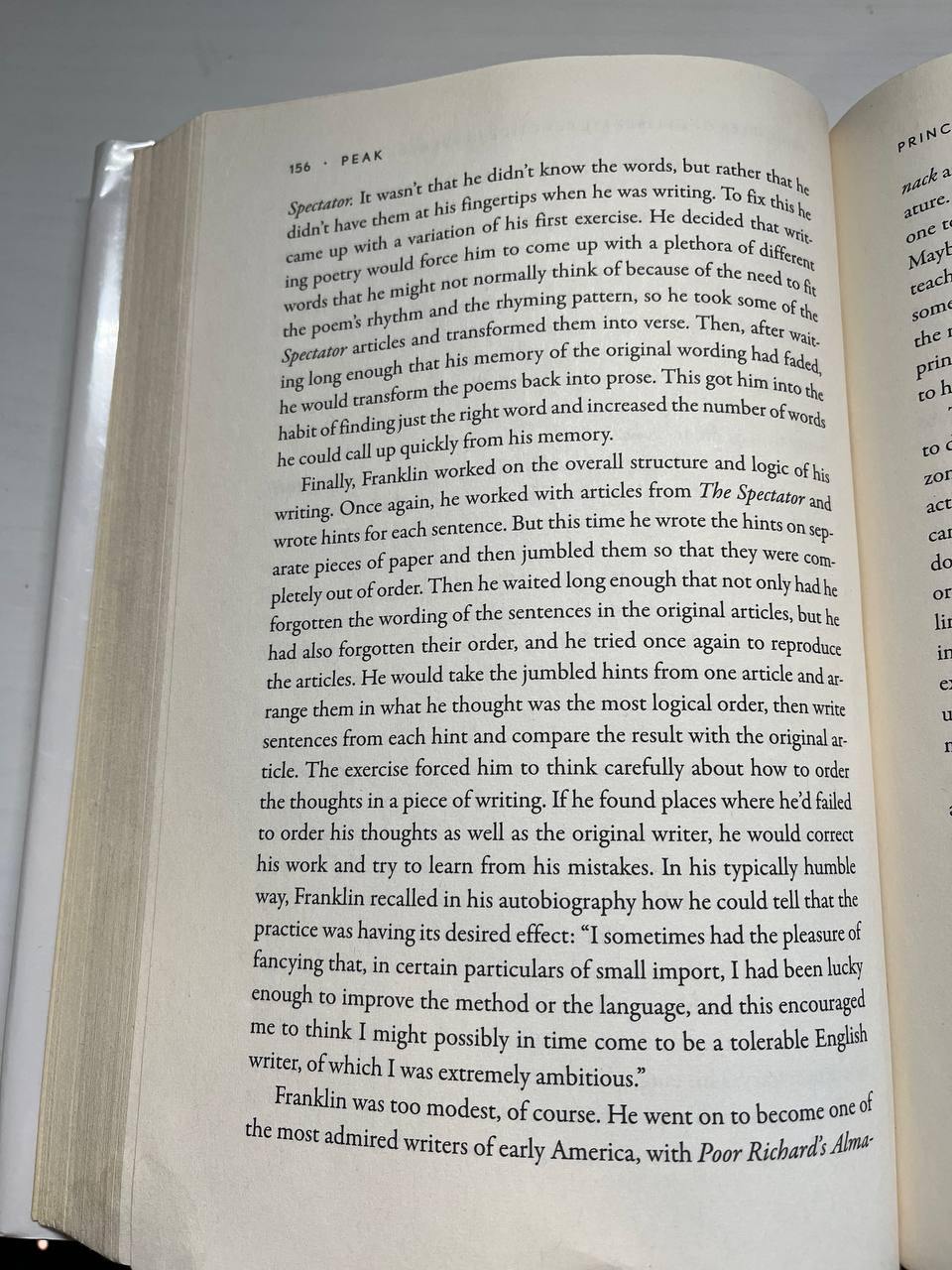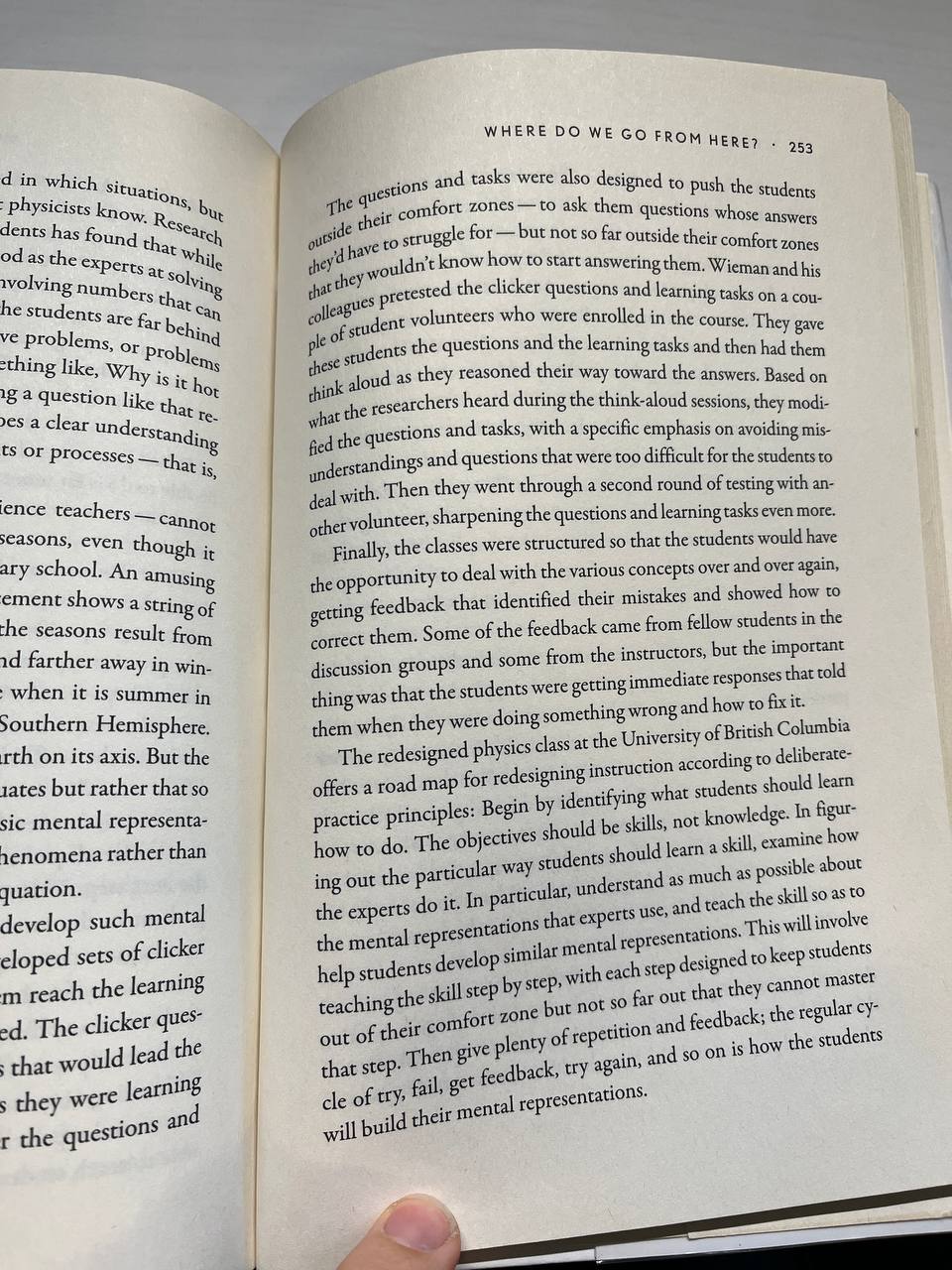Highlights from Peak: Secrets From The New Science of Expertise
Last updated:
This month, I read Peak after my mentor at work recommended. I’ve been thinking a lot about expertise, specifically in the language learning domain. I found this book hard to put down. The main takeaway from it is that talent exists but expertise can be learned.
You can break down a skill and apply deliberate practice and improve.
Definitely recommend giving it a read if you can. I got mine from the local library.
Highlights
These are things I highlighted while I was reading.
The Basic Blueprint
Shaan, one of the hosts of My First Million, talks a lot about blueprints. He tries to pursue businesses where there is a clear blueprint, aka proven success from someone else.
This is the basic blueprint for getting better in any pursuit: get as close to deliberate practice as you can.
In practice this boils down to purposeful practice with a few extra steps: first, identify the expert performers, then figure out what they do that makes them so good, then come up with training techniques that allow you to do it, too.
(Ericsson and Pool, 103)
Ben Franklin and Copywork
This might have been my favorite story shared in the book. We all know Ben Franklin is regarded as a great writer. But, few people know he taught himself how to become a great writer using clever techniques.
He first set out to see how closely he could reproduce the sentences in an article once he had forgotten their exact wording. So he choose several of the articles whose writing he admired and wrote down short descriptions of the content of each sentence — just enough to remind him what the sentence was about. After several days he tried to reproduce the articles from the hints he had written down. His goal as not so much to product word-for-word replica of the articles as to create his own articles that were as detailed and well written as the original. Having written his reproductions, he went back to the original articles, compared them with his own efforts, and corrected his versions where necessary. This taught him to express ideas clearly and cogently.
What’s funny is the other host of My First Million, Sam Parr, has a course called CopyThat, which has a picture of Ben Franklin and talks about how he taught himself how to write using copywork. I never knew the original story though so it was cool for that to come full circle.
Now there are a couple more paragraphs I want to quote because it’s worth understanding all the exercises Ben did to help himself improve.
The biggest problem he discovered from these exercises was that his vocabulary was not nearly as large as those of the writers for The Spectator. It wasn’t that he didn’t know the words, but rather that he didn’t have them at his fingertips when he was writing…
I’m highlighting this one because it’s exactly one of the problems I’m running into as I raise my daughter bilingual and not having rich vocabulary available at my fingertips.
To fix this he came up with a variation of his first exercise. He decided that writing poetry would force him to come up with a plethora of different words that he might not normally think of because he needed to fit the poem’s rhythm and the rhyming pattern, so he took some of the Spectator articles and transformed them into verse. Then, after waiting long enough that his memory of the original wording had faded, he would transform the poems back into prose. This got him into the habit of finding just the right word and increased the number of words he could call up quickly from his memory.
Now I’m not a poetry-guy but you know what is like poetry? Singing, specifically, rapping. So I wonder if I could apply this same technique to Spanish where I write lyrics as a way to practice the same type of exercise.
There is one final exercise I want to share from the book.
Finally, Franklin worked on the overall structure and logic of his writing. Once again, he worked with articles from The Spectator and wrote hints of each sentence. But this time he wrote the hints on separate pieces of paper and then jumbled them so that they were completely out of order. Then he waited long enough that not only had he forgotten their order, and he tried once again to reproduce the articles. He would take the jumbled hints from one article and arrange them in what he thought was the most logical order, then write sentences from each hint and compare the result with the original article. The exercise forced him to think carefully about how to order the thoughts in a piece of writing. If he found places where he’d failed to order his thoughts as well as the original writer, he would correct his work and try to learn from his mistakes.
This was genius. Again, it reminds me of storytelling and putting the pieces together in a logical way. I loved reading. Here’s the two pages if you want to read this full section yourself.


The Three Fs
To effectively practice a skill without a teacher, it helps to keep in mind three Fs: Focus. Feedback. Fix it. Break the skill down into components that you can do repeatedly and analyze effectively, determine your weaknesses, and figure out ways to address them.
(Forgot to write down what page…)
This is pretty much for the formula. At least at a low-level. It can be difficult to break down the components but if you can get past that, you can improve at anything.
Jump Math by John Mighton
I haven’t looked into this yet, but there was a curriculum developed by a Canadian mathematician.
The program uses the same basic principles found in deliberate practice: breaking learning down into a series of well-specified skills, designing exercises to teach of those skills in the correct order, and using feedback to monitor progress.
(Ericsson and Pool, 255)
Deslauriers and Schelew
Another example worth researching is a postdoctoral student and assistant who taught college-level physics using deliberate practice and other techniques.
(Ericsson and Pool, 244)
Study Mental Representations
I think this is the same as “mental model” but it’s a reminder for me to study experts and understand how they think.
Furthermore, very little has been done to learn about the mental representations that successful athletes use. The ideal approach to fixing this would be to have athletes verbally report their thinking while they are performing, which would make it possible for researchers, coaches or perhaps even the athletes themselves to design training tasks to improve their representations of game situations, in the same way we described in chapter 3.
Again, the key here is trying to understand the mental models of the experts in your field. Feels super hard to do unless you can find interviews of them or if you can somehow invite them on a podcast and directly ask them about it.
(Ericsson and Pool, 248)
Just Outside the Comfort Zone
Another tip I picked up was getting right outside the comfort zone when trying to expand your skills.
The questions and tasks were also designed to push the students outside their comfort zones — to ask them questions whose answers they’d have to struggle for — but not so far outside their comfort zones that they wouldn’t know how to start answering them. Wieman and his colleagues pretested the clicker questions and learning tasks on a couple of student volunteers who were enrolled in the course. They gave these students the questions and the learning tasks and had them think aloud as they reasoned their way toward the answers. Based on what the researchers heard during the think-aloud sessions, they modified the questions and tasks, with a specific emphasis on avoiding misunderstandings and questions that were too difficult for the students to deal with. Then they went through a second round of testing with another volunteer, sharpening the questions and learning tasks even more.
As you can see, there’s merit for challenging yourself outside your comfort zone but also getting feedback and readjusting when you learn where the holes are in your knowledge. Reminds me a little bit of the Feynman technique.
(Ericsson and Pool, 253).
This page is actually really good so here it is for you to read.

Prepping kids for success
While this talks about students in an academic context, I’d like to take this advice and apply it to my daughter so she can benefit from these approaches.
The best way to help students develop their skills and mental representations in an areas is to give them models they can replicate and learn from, just as Benjamin Franklin did when he improved his writing by reproducing articles from The Spectator. They need to try and fail — but with ready access to models that show what success looks like.
(Ericsson and Pool, 255).
End
That’s all for my highlights. Hope you enjoyed it and let me know if you want to discuss the book! I always love talking about this kind of stuff with friends.